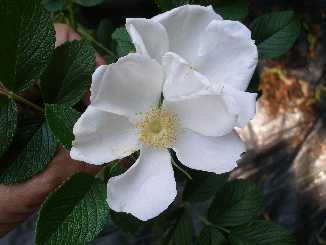
 198 'Alba' Rugosa
Rose 'Alba' is a white flowered variant
of Rosa Rugosa Rose also called the
'Hedgehog Rose' and 'The Japanese Rose', 8 feet tall, hardy in
zone 3. flowers all summer.
198 'Alba' Rugosa
Rose 'Alba' is a white flowered variant
of Rosa Rugosa Rose also called the
'Hedgehog Rose' and 'The Japanese Rose', 8 feet tall, hardy in
zone 3. flowers all summer.CHOOSING, GROWING and CARING for ROSES in the NORTHEASTERN UNITED STATES or more specifically in my Nursery in Albany County, NY by Andrew Van Cleve with pictures from my newsletter (Links to my catalogs at the bottom). If pictures dont open click this link www.floweringshrubfarm.com/roses.htm
The hardiness of the roots of a plant are usually 40 degrees less hardy than the stems or buds.
When the air temperature is 20 below 0 for several days the soil temperature 6 inches under ground may be 20 above 0. For every day that air temperatures remain below soil temperatures more warmth is radiated from the soil. A blanket of snow or mulch can slow this process.

 198 'Alba' Rugosa
Rose 'Alba' is a white flowered variant
of Rosa Rugosa Rose also called the
'Hedgehog Rose' and 'The Japanese Rose', 8 feet tall, hardy in
zone 3. flowers all summer.
198 'Alba' Rugosa
Rose 'Alba' is a white flowered variant
of Rosa Rugosa Rose also called the
'Hedgehog Rose' and 'The Japanese Rose', 8 feet tall, hardy in
zone 3. flowers all summer.
So the deeper the roots are buried the less susceptible they will be to winter kill.
In a pot or mound of soil the loss of heat is greater, so the smaller the soil mass the more hardy the plants have to be.
When they are planted deeper they are less susceptible to mildew and need less watering. On the other hand lack of drainage/irrigation is the most common cause of any plant dying if its reasonably hardy and planted in the right way.
A) What they require & Planting
Recurrent flowering roses usually seem to require around 6 hours or more of sun, a well drained, garden soil with a pH 6.5, adequate fertility and moisture. Many will produce several hundred flowers over the entire three or four months that they bloom so most will only have a few flowers at a time.

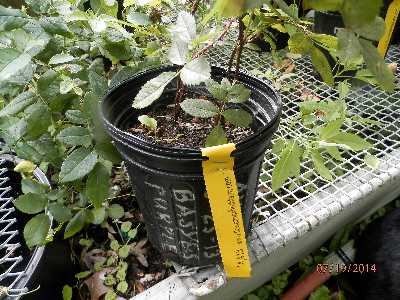 006) 'BASYE'S PURPLE'
Hybrid Rugosa Rose, Basye's Purple (Rosa rugosa x Rosa foliolosa
Hybrid) Rose, (zones 5 thru 8, 5 feet x 5 feet), blooms all summer
for us.
006) 'BASYE'S PURPLE'
Hybrid Rugosa Rose, Basye's Purple (Rosa rugosa x Rosa foliolosa
Hybrid) Rose, (zones 5 thru 8, 5 feet x 5 feet), blooms all summer
for us.
Non recurrent Once bloomers can tolerate somewhat less sun and many tolerate less fertility. Most will produce several hundred flowers over the entire three to six weeks they bloom so most will be covered with flowers throughout their bloom time.
I suggest growing both together so that early on you get the big display and fragrance of the once bloomers while later you still have some bloom remaining from the repeat bloomers. I grow Roses in hedges and masses alternating between recurrent bloom and once blooming.
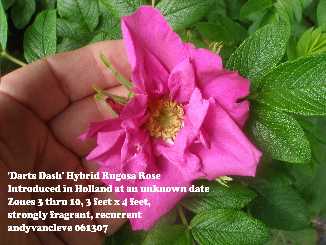
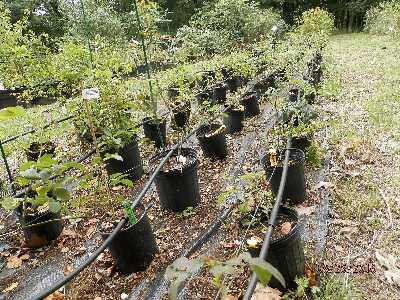 172 Dart's Dash 'Darts Dash' Hybrid Rugosa Rose introduced in Holland (zones 3
thru 10, 3 feet x 4 feet ), strongly fragrant, it blooms for us
all summer.
172 Dart's Dash 'Darts Dash' Hybrid Rugosa Rose introduced in Holland (zones 3
thru 10, 3 feet x 4 feet ), strongly fragrant, it blooms for us
all summer.
DONT PLANT A ROSE WHERE ANOTHER ROSE HAS BEEN UNLESS YOU REPLACE THE SOIL IN AN AREA 2 FEET BY 2 FEET BY 2 FEET. This is because of a problem called specific replant disease. Its probably a build up in the soil of diseases and nematodes damaging to roses. It can happen with many plants so if one species of plant has died, either replace the soil or try a different species.
When amending the soil it is best to prepare beds not holes.
Amend like for a vegetable garden. I find that I can grow really great tomatoes in my rose beds. If those tomatoes get blossom end rot many roses wont do as well.
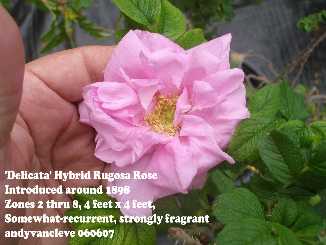
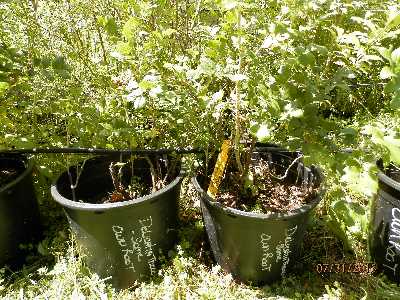 96) DELICATA Hybrid
Rugosa Rose, 'Delicata
Hybrid Rugosa Rose introduced around 1898 by Cooling
(zones 3 thru 8, 4 feet x 4 feet ), strongly fragrant, it blooms
for us eratically throughout summer (somewhat recurrent), ("500 Popular
Roses For American Gardeners" Barron's, 139) ("Growing
Roses Organically" Wilde, 71, 134, zones 3-10, DR-0/0),
(Taylor's Guides "Roses" Ondra, 136, zones 3-9).
96) DELICATA Hybrid
Rugosa Rose, 'Delicata
Hybrid Rugosa Rose introduced around 1898 by Cooling
(zones 3 thru 8, 4 feet x 4 feet ), strongly fragrant, it blooms
for us eratically throughout summer (somewhat recurrent), ("500 Popular
Roses For American Gardeners" Barron's, 139) ("Growing
Roses Organically" Wilde, 71, 134, zones 3-10, DR-0/0),
(Taylor's Guides "Roses" Ondra, 136, zones 3-9).
In sandy soils add lots of organic amendments and a soaker hose.
In clay soils add lots of amendments and a land drain or french drain.
Sometimes its a good idea to build up a soil by layering up on top of your current soil. I do this in areas where the subsoil is just beneath the surface. Some roses thrive if you use the volcano method of planting.
After digging the hole but before planting water thoroughly several times allowing the water to drain completely each time. If water collects in the bottom and remains for to long a time it might be a good idea to add a drain of some sort.
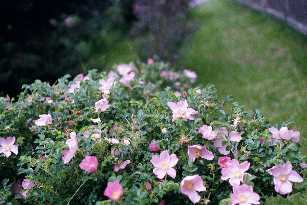
 25) 'FRU DAGMAR
HASTRUP' Hybrid Rugosa Rose, zone 3, 3 feet
tall, recurrent.
25) 'FRU DAGMAR
HASTRUP' Hybrid Rugosa Rose, zone 3, 3 feet
tall, recurrent.
Plant the rose with the bud union (the area on the stem where the branches begin) 2 or more inches below soil level in zone 5. If the bud union remains above the soil animals and insects can damage it and kill it back easily to the root. If its grafted on rootstock the plant that then regrows from that root will not be the one you chose.
When you are finished there should be a thicket of stems from the soil, not just one (this applies to all roses whether they are grafted or own root).
The best root stock for grafted roses is guarenteed virus free, Rosa multiflora (propagated from seed not cuttings).
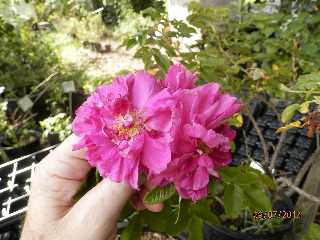
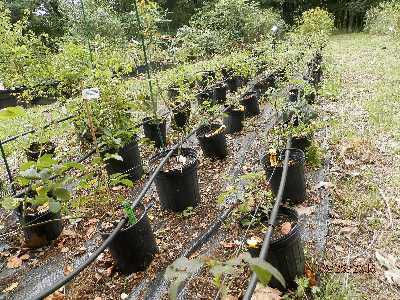 29) 'HANSA' Hybrid
Rugosa Rose, 'Hansa' Hybrid Rugosa Rose introduced around 1905 (Zones 3
thru 7, 5 feet x 5 feet) fragrant flowers bloom late spring and
throughout summer.
29) 'HANSA' Hybrid
Rugosa Rose, 'Hansa' Hybrid Rugosa Rose introduced around 1905 (Zones 3
thru 7, 5 feet x 5 feet) fragrant flowers bloom late spring and
throughout summer.
If the rose is bare-root its a good idea to soak it overnight in a slurry of warm water, compost and garden soil to provide the bare roots with a mud-like coating to prevent dessication during the planting process while providing nutrients and a good drink.
Dig a hole in your prepared bed that provides enough space for whatever size the mature plant will be. A cone of soil in the bottom of the hole over which the bare root rose can stand supported and a straight piece of wood set across the hole, rim to rim that can help set the bud union at the correct level will sometimes simplify what can be a rather complicated process. Water the newly planted rose several times to remove any subterranian air pockets. Use the excess soil from the hole to build a hill over the top of the canes to help cool it and prevent desication until it becomes established. Once the plant has fully leafed out (indicating it has rooted) this hill can be removed (sometimes it can take 60 days to root). I remove the hill by washing it away.
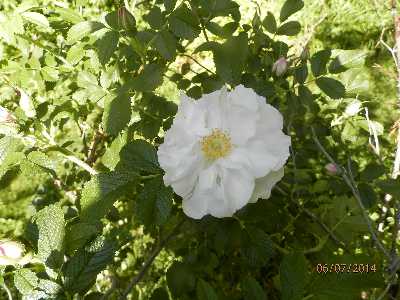
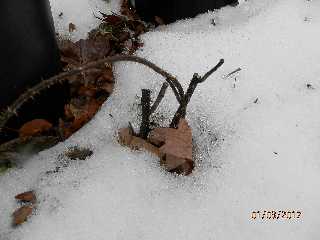 Henry Hudson (1979) Hybrid
rugosa, zones 3a and warmer, 2 to 4 feet x 2 to 4 feet, seedling
of schneezwerg,
Henry Hudson (1979) Hybrid
rugosa, zones 3a and warmer, 2 to 4 feet x 2 to 4 feet, seedling
of schneezwerg,
B) Feeding; I fertilize with Espoma dehydrated manure or Rose Tone in late winter and July (or when the non-recurrent old roses stop flowering).
C) Watering; Get a timer and water through a soaker hose or drip line regularly. Newly planted shrubs cannot be allowed to wilt for any reason.
D) When to prune repeat flowering roses.
The traditional time to prune repeat flowering roses is from mid winter to early spring but remember that;
in zone 5 or less prune late,
in zone 6 or warmer one can prune earlier except in years when winters are severe.
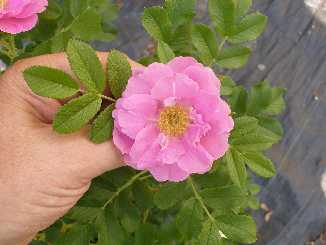
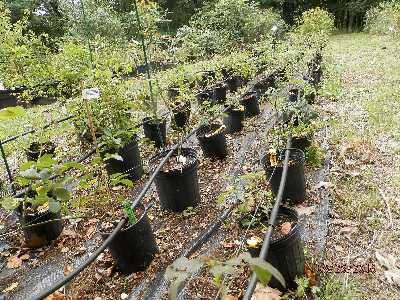 102) JENS MUNK
Hybrid Rugosa Rose, Introduced in 1979,
Hardy in zones 4 through 8, 6 feet tall x 5 feet wide.
102) JENS MUNK
Hybrid Rugosa Rose, Introduced in 1979,
Hardy in zones 4 through 8, 6 feet tall x 5 feet wide.
I think its a good idea not to prune modern and repeat blooming roses until after growth buds at mid stem begin to swell. Generally the idea is to prune after the risk of a serious frost is past but before your plants have put on a lot of growth that just has to be cut off.
In the nursery I usually dont prune until the plants completely leaf out and then only to remove dead parts or to train the shrub to a particular shape.
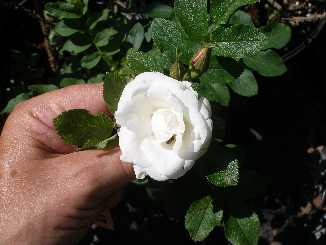
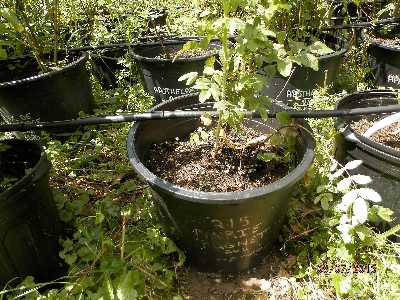 215 Marie Bugnet Hybrid Rugosa, Introduced in 1963
white double, Hardy in zones 2 through 9, 3 feet tall x 3
feet wide.
215 Marie Bugnet Hybrid Rugosa, Introduced in 1963
white double, Hardy in zones 2 through 9, 3 feet tall x 3
feet wide.
E) Dead heading (removing faded flowers) and more pruning; on repeat blooming varieties will encourage rebloom. Not dead heading will reduce the amount of new growth and therefore the number of new buds.
On a hybrid tea, dead heading will involve cutting back to the first set of 5 leaflets that point away from the center.
The farther back that stems are cut;
1) the larger flowers will get
2) the longer it will take for them to rebloom.
Pruning
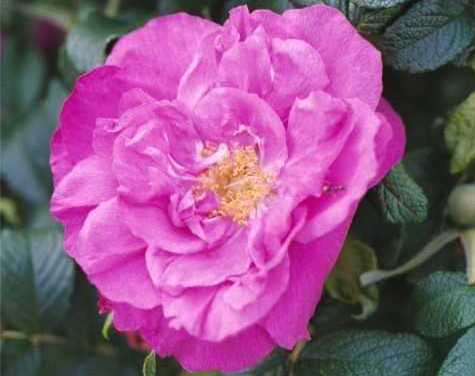
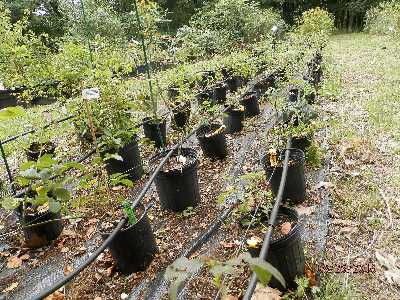 36)
'MAGNIFICA'_Hybrid Rugosa Rose zones 4 thru 8, 5'
tall, recurrent, 4 inch double flowers, (Taylor's Guides "Roses"
Ondra, 141, zones 4-8), (hr/5feet/red-purple/double/4inches/ff).
36)
'MAGNIFICA'_Hybrid Rugosa Rose zones 4 thru 8, 5'
tall, recurrent, 4 inch double flowers, (Taylor's Guides "Roses"
Ondra, 141, zones 4-8), (hr/5feet/red-purple/double/4inches/ff).
A severe pruning of a recurrent blooming modern rose down to 5 or 6 inches of the ground in spring, as long as the bud union (in a grafted rose) is not dead, will produce new growth.
Open the center, removing all but a few of the strongest canes. These remaining canes should then be cut back to an outward facing bud.
An unpruned hybrid tea will produce growth that is too week to produce large flowers. Sooner or later it will get very large with flowers only near the top. Then it will eventually die due to overcrowded canes and a buildup of dead wood at the crown (or graft) that invite disease or insects ("Roses of America", Scanniello, 86 & 93).
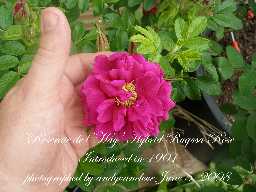
 51) Roseraie de
l'hay Hybrid Rugosa Rose 'Roseraie de l'Hay'
Hybrid Rugosa Rose introduced in 1901, (zones 3 thru 8, 8'x8'),
orange yellow fall foliage, strongly fragrant, it blooms for us
all summer when regularley dead headed and fertilized (
"Best Rose Guide" Phillips & Rix, 187, zone 4(-30
f)), ("The Encyclopedia of Roses" McKeon, 171, zones
4-8), ("Growing Roses Organically" Wilde, 172, zones
3-10, DR-0/0), ("Classic Roses" Beales, 67,
fllfat:246), (Taylor's Guides "Roses" Ondra, 140, zones
3-8). Growing well in a 45 gallon pot near the sidewalk.
51) Roseraie de
l'hay Hybrid Rugosa Rose 'Roseraie de l'Hay'
Hybrid Rugosa Rose introduced in 1901, (zones 3 thru 8, 8'x8'),
orange yellow fall foliage, strongly fragrant, it blooms for us
all summer when regularley dead headed and fertilized (
"Best Rose Guide" Phillips & Rix, 187, zone 4(-30
f)), ("The Encyclopedia of Roses" McKeon, 171, zones
4-8), ("Growing Roses Organically" Wilde, 172, zones
3-10, DR-0/0), ("Classic Roses" Beales, 67,
fllfat:246), (Taylor's Guides "Roses" Ondra, 140, zones
3-8). Growing well in a 45 gallon pot near the sidewalk.
To prune Hybrid Perpetuals remove a proportion of the older wood and cut back all the canes by half during late winter while still dormant. Repeat after the first flowering.
Bourbons are pruned while still dormant at the beginning of the growing season after its several years old. All shoots are shortened by 1/3. As plants age remove older wood. After flowers fade laterals are cut back by 1/3.

 178 Rotes Meer Hybrid Rugosa Rose 'Rotes Meer' 'Purple Pavement'
Hybrid Rugosa Rose introduced in 1983. (Zones 3 thru 9, 5 feet x
5 feet) flowers bloom late spring through summer, ("The Encyclopedia of Roses"
McKeon, 147, zones 3-8).
178 Rotes Meer Hybrid Rugosa Rose 'Rotes Meer' 'Purple Pavement'
Hybrid Rugosa Rose introduced in 1983. (Zones 3 thru 9, 5 feet x
5 feet) flowers bloom late spring through summer, ("The Encyclopedia of Roses"
McKeon, 147, zones 3-8).
Chinas dont need pruning as such to promote rebloom and so we only pinch off faded flowers and remove dead wood. Severe pruning should only be attempted when the plant is dormant.
Pinch off flowers on Damask roses after they have faded. Hard pruning may be done immediately after all flowering has stopped, Early July in the Albany area, but isn't necessary except to remove dead wood (remember that on a spring blooming old rose, next years flower buds are formed between the longest day of the year (locally June 20) and frost, prune too late and no flowers next spring).
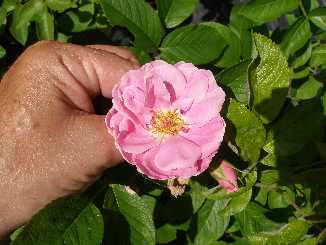
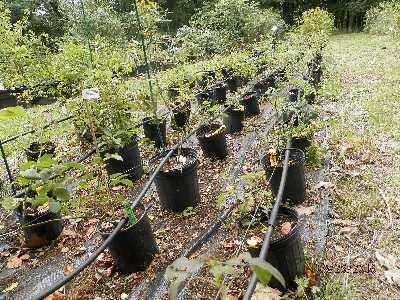 54) Sarah Van Fleet Hybrid Rugosa Rose Hardy in zones 6
through 9, 8 feet tall x 6 feet wide.
54) Sarah Van Fleet Hybrid Rugosa Rose Hardy in zones 6
through 9, 8 feet tall x 6 feet wide.
Galicas can be pruned like a damask as the flowers fade. I remove dead parts at anytime as long as the living parts are in leaf so its easy to see what shouldn't be cut off.
Albas are very upright and dont sucker as some other old garden roses do. Some of the older growth may be removed on mature specimens (Early July in the Albany, NY area) its best to be conservative with this removal as the best flowers appear on second year growth. Plants on their own roots may benefit from occasional hard pruning but flowers may be lost the following year.
Rugosa's sucker a lot so if you prune it hard it will probably send up a lot of suckers. Sometimes suckering roses are grafted onto a root stock to control this tendency (then the root stock can sometimes sucker). I think the best way of preventing a rugosa rose from taking over is to prune lightly, mow regularly and fertilize with a slow acting fertilizer. I dont prune them much in the nursery except to remove dead parts (which I then burn). I try not to cut stems below 30 inches or so unless I remove it all the way back to below soil. Watch for insect damage in old pruning scars and remove.
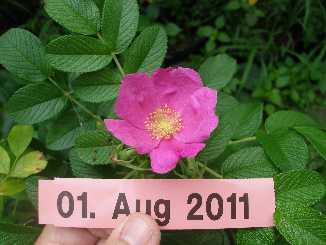
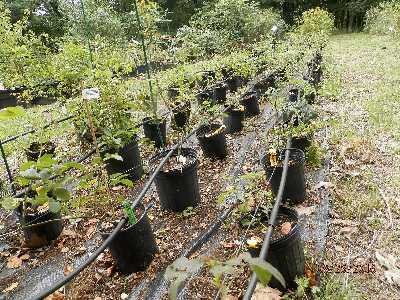 55) 'SCABROSA Hybrid Rugosa Rose 'Scabrosa Hybrid Rugosa Rose
introduced by Harkness in 1950. (Zones 3 thru 8, 5 feet x 5 feet)
shade tolerant, moderately fragrant flowers bloom late spring and
throughout summer, reddish gold fall foliage ("Growing
Roses Organically" Wilde, 174, zones 3-10, DR-0/0),
("Classic Roses" Beales, 62, fllf:247), (Taylor's
Guides "Roses" Ondra, 142, zones 3-8). Growing well in
a 45 gallon pot near the sidewalk.
55) 'SCABROSA Hybrid Rugosa Rose 'Scabrosa Hybrid Rugosa Rose
introduced by Harkness in 1950. (Zones 3 thru 8, 5 feet x 5 feet)
shade tolerant, moderately fragrant flowers bloom late spring and
throughout summer, reddish gold fall foliage ("Growing
Roses Organically" Wilde, 174, zones 3-10, DR-0/0),
("Classic Roses" Beales, 62, fllf:247), (Taylor's
Guides "Roses" Ondra, 142, zones 3-8). Growing well in
a 45 gallon pot near the sidewalk.
I dont usually prune until July except to remove dead branches or faded flowers. Some of my old roses if left unpruned for 3 or 4 years have to be cut back somewhat in the 4th year or they get a bit to leggy. The Alba roses are hardly pruned at all.
F) Insect Pests and how I deal with them at Azalea House Flowering Shrub Farm
I have 3 different locations for growing roses. In one area they are watered via drip irrigation. In another there are overhead mist sprayers where I can easily apply fertilizer, insecticidal soap and neem with a dositron.
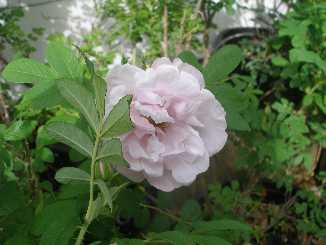
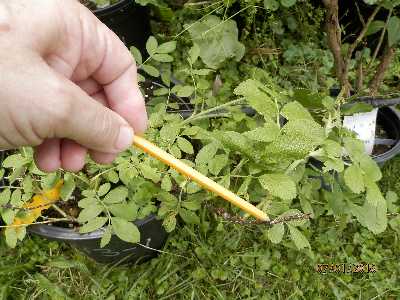 143 Schneekoppe,
Schneekopf, Snow Pavement 'Schneekoppe',
'Schneekopf', Snow Pavement Hybrid Rugosa Rose introduced in 1984
(zones 3 thru 8, 4'x4') fragrant, pale lavender flowers rapidly
fading to white bloom from late spring throughout summer when regularly dead headed and
fertilized.
143 Schneekoppe,
Schneekopf, Snow Pavement 'Schneekoppe',
'Schneekopf', Snow Pavement Hybrid Rugosa Rose introduced in 1984
(zones 3 thru 8, 4'x4') fragrant, pale lavender flowers rapidly
fading to white bloom from late spring throughout summer when regularly dead headed and
fertilized.
In the drip irrigation area I walk among the plantings each day checking to see that the drip lines are properly alligned so that everything is being watered and fertilized. While I'm out there I look for damaged parts on plants which I usually prune off and place them in a large plastic garbage bag for burning in a burn can we keep for that purpose.
Aphids. I spray them off the foliage with a hard blast of water (blasting) or sometimes I mash the new growth where they congregate between my fingers (mashing aphids too). Usually I dont see aphids much because they are such a good source of vitamins for my beneficial insects (just call them Ben). At the plant sale I use insecticidal soap.
Thrips. Ben takes care of these for me too (lacewings). Otherwise I remove affected blossoms and drop them into a nice hot fire. At the plant sale I use insecticidal soap.
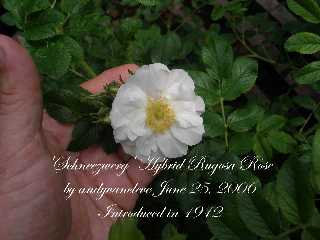
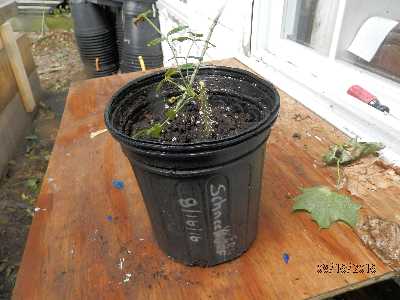 144 Schneezwerg,
Snow Dwarf (R. rugosa x R. bracteata) Hybrid Rugosa Rose 'Schneezwerg', 'Snow Dwarf' Hybrid
Rugosa Rose introduced in 1912, (zones 4 thru 8, 3 feet x 3
feet), it blooms for us all summer when regularly dead headed and
fertilized. The last one will soon be planted in a 45 gallon pot
from which we will take cuttings.
144 Schneezwerg,
Snow Dwarf (R. rugosa x R. bracteata) Hybrid Rugosa Rose 'Schneezwerg', 'Snow Dwarf' Hybrid
Rugosa Rose introduced in 1912, (zones 4 thru 8, 3 feet x 3
feet), it blooms for us all summer when regularly dead headed and
fertilized. The last one will soon be planted in a 45 gallon pot
from which we will take cuttings.
Spider mites. Blasting works though I dont see them much. At the plant sale I use neem oil 3 in 1.
Scale. I scrape them off with a stick and drop them in the fire. Some use dormant oil.
Cane borers. Find their holes and stick a pin in mashing them. You can also prune the affected stem back to healthy pith, then stick a thumbtack in (the brightly colored head attracts me back for another look but the metal head does a good job of keeping the borers out.
Caterpillars. Hand pick and drop them in a fire. Mashing works well too. Some people use BT (Bacillus thuriengensis) but I think its used to readily. Keep things like that for when nothing else works or your likely to develop a resistant population that nothing works against. At the plant sale I use insecticidal soap.

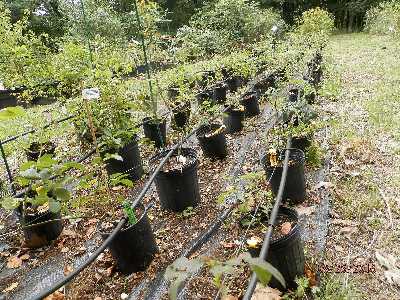 146 Souvenir de
Philemon Cochet Hybrid Rugosa Rose, Introduced in 1900,
Hardy in zones 3 through 9, 5 feet tall x 5 feet wide.
146 Souvenir de
Philemon Cochet Hybrid Rugosa Rose, Introduced in 1900,
Hardy in zones 3 through 9, 5 feet tall x 5 feet wide.
Rose midges. New growth shrivels and blackens, remove affected plant parts and burn them. Remove litter and other material from around the plant (and burn it). Because this insect pupates in the soil the laying down of black plastic on that soil can often interfere with their lifecycle.
Japanese Beatles. Mash em. Or hold a can of soapy water under where they are and tap the branch, theyll usually fall in and drown. Later I screen them out and burn em. Then I reuse the soapy water. Lots of people just leave these cans filled with dead japanese beatles lying around for someone else to clean up. At the plant sale I use neem oil 3 in 1.
Methods used: Blasting-removal with a hard jet of water from your hose.
Mashing-smashing them between your fingers.
Ben-beneficial insects.
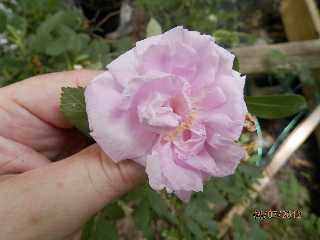
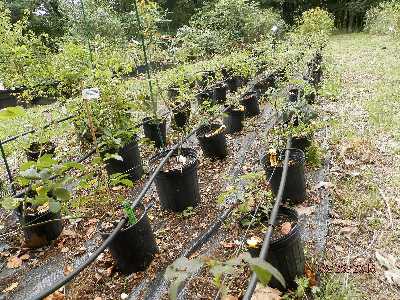 208 'Wasagaming' 1939 Hybrid Rugosa Rose is Hardy in zones
3 through 9, 6 feet tall x 6 feet wide.
208 'Wasagaming' 1939 Hybrid Rugosa Rose is Hardy in zones
3 through 9, 6 feet tall x 6 feet wide.
Scraping-Scrape them off with a stick.
Burning-always be sure that there are no flamable materials around your burn can. Next, never leave it unattended (this is only to burn affected plant parts and the insects themselves) one of those nice outside fireplaces works great and you can hang around and have a cup of java.
G) Winter Protection.
Jean asked me August 14, 2006 about pruning in late summer and winter protection.
I answered;
When cutting back you must think about the fact that roses store food in their canes. Less cane on the plant then less food stored. Sometimes roses die back in winter. If the canes are 30 inches tall and it dies back 10 inches you''ll be removing some dead wood next spring. If the canes are only 10 inches tall or less you'll be replacing the rose. Some roses (notably hybrid tea's but they've been hybridized with other types so much characteristics can show up elsewhere), when pruned in fall or early winter have been known to die (Steven Scaniello has observed this). Leaving roses unpruned and tying to some sort of support so that they dont get whipped around by winter winds (besides you can leave the heps on for decoration in winter). As far as mounding the plant; as long as the crown is below soil so that a thicket of stems rise from the soil not just one, rodent damage should be decreased. If you are in zone 5 and are talking about a zone 5 rose, mounding with a heap of damp sand in the absence of snow might be a good idea (I keep several bags of sand in my basement for this purpose). Later in the winter, if there's no snow and extremely cold temperatures with desicating winds are forecast. You can dump a heap of damp sand on top and it will freeze. Later in the spring, when the sand thaws, I wash it away with a hose.
With climbing roses I train a main stem along the ground where it can easily be buried and where there is little or no dessication from the wind.
Andy
H) Own Root Versus Rootstock minus the religion, politics and self interest you get in most explanations.
Advantages and Disadvantages.
Own root has the advantage that if an animal rings your plant (removing all bark for the entire circumference killing your plant from that point and above), and it is well rooted your plant should still regenerate from what is left. This is also one of the reasons for planting with the crown or union 2 inches or more below the soils surface so that the individual branches above the crown poke from the soil. Its more likely to root from those individual branches and its much harder for an animal or insect to ring anything when there are multiple stems.
Grafted has the advantage that you dont need a Greenhouse to propagate the plants. Just plant seeds of a species rose that has proven itself as a good root stock or a pre-grown, small, cutting grown plant that has a history of doing well in the local soils. Thousands of these rootstock plants are planted every year and then grown for a couple years before grafting a bud on them.
You can observe the benefit of mass production by looking at how badly formed the bare root plant often is. When the rootstock is initially planted it is usually inserted into the soil by a farmhand leaning over the rear end of a tractor. A plow opens a furrow, the farmhand inserts the plant and another plow closes the furrow. Often the plant is dragged so that all the roots are on one side.
Own Root has the disadvantage that you have to grow it for the entire period that the rootstock has been grown. It has the advantage that due to the fact that it is greenhouse grown the roots are much more likely to be evenly distributed.
Grafted has the advantage that The Scion (part of the plant above the graft) only has to be growing for 2 years to get the growth benefit of 4 years (because the rootstock has already established itself over the previous 2 years of growth. If you are a commercial grower you might plant 4 different rootstocks by the thousands that have proven to be dependable in different soil types and/or climates (Dr. Huey for the North, Fortunianna in the South, etc.). Then you could purchase buds from the different hybridists and go into your fields to graft a hundred of one variety on each rootstock and a hundred of another on each rootstock (or however many your marketing analysis determines you will sell). Then you grow the plant for 2 more years before digging it for sale.
I grow both own root and grafted on Rosa multiflora. Every year when I prune in July I take the cuttings to stick in my propagation boxes. Some varieties dont root as easily as others and so are only available grafted.
Rosa multiflora is grown from seed. Viruses aren't shared through the seed coat so plants grown from seed are guarenteed virus free. Most virused roses get the virus from their root stock. So roses grafted on multiflora are most likely to be virus free.
My Rose catalog is at: www.floweringshrubfarm.com/avirtual.htm
Home Email me We grow plants to sell retail during our Plant Sale.
In June I take cuttings rooted over the previous year and pot them into 3 gallon pots. The date I first started growing that rooted cutting is written on the side of the pot with a paint pen. A 3 gallon potted rose marked 2012 on the side of the pot will be two years old or $15 as of spring 2014 (up until then they will be $10 each but you should wait until they flower proving the variety). When they outgrow the 3 gallon pot we repot into a 7 gallon for $30, when it outgrows the 7 gallon we transplant into a 15 gallon for $50 or a 25 gallon for $70 or more (when I have to many of a variety I may put it on sale at the previous years price). Each year I fertilize Roses with Espoma Rose Tone (the first of March, April, May, june and July) then prune plants back in July when I take more cuttings. When plants flower proving the vatiety I paint a big OK on the side of the pot.
Aphids. I spray them off the foliage with a hard blast of water (blasting) or sometimes I mash the new growth where they congregate between my fingers (mashing aphids too). Usually I dont see aphids much because they are such a good source of vitamins for my beneficial insects (just call them Ben). At the plant sale I use insecticidal soap.
Thrips. Ben takes care of these for me too (lacewings). Otherwise I remove affected blossoms and drop them into a nice hot fire. At the plant sale I use insecticidal soap.
Spider mites. Blasting works though I dont see them much.
Scale. I scrape them off with a stick and drop them in the fire. Some use dormant oil.
Cane borers. Find their holes and stick a pin in mashing them. You can also prune the affected stem back to healthy pith, then stick a thumbtack in (the brightly colored head attracts me back for another look but the metal head does a good job of keeping the borers out.
Caterpillars. Hand pick and drop them in a fire. Mashing works well too. Some people use BT (Bacillus thuriengensis) but I think its used to readily. Keep things like that for when nothing else works or your likely to develop a resistant population that nothing works against. At the plant sale I use insecticidal soap.
Rose midges. New growth shrivels and blackens, remove affected plant parts and burn them. Remove litter and other material from around the plant (and burn it). Because this insect pupates in the soil the laying down of black plastic on that soil can often interfere with their lifecycle.
Japanese Beatles. I Mash em. Or hold a can of soapy water under where they are and tap the branch, theyll usually fall in and drown. Later I screen them out and burn em. Then I reuse the soapy water. Lots of people just leave these cans filled with dead japanese beatles lying around for someone else to clean up. At the plant sale I sometimes use neem oil 3 in 1.
Methods used: Blasting-removal with a hard jet of water from your hose.
Mashing-smashing them between your fingers.
Ben-beneficial insects.
Scraping-Scrape them off with a stick.
Burning-always be sure that there are no flamable materials around your burn can. Next, never leave it unattended (this is only to burn affected plant parts and the insects themselves) one of those nice outside fireplaces works great and you can hang around and have a cup of java.
Jean asked me August 14, 2006 about pruning in late summer and winter protection.
I answered;
When cutting back you must think about the fact that roses store food in their canes. Less cane on the plant then less food stored. Sometimes roses die back in winter. If the canes are 30 inches tall and it dies back 10 inches you'll be removing some dead wood next spring. If the canes are only 10 inches tall or less you'll be replacing the rose. Some roses (notably hybrid tea's but they've been hybridized with other types so much characteristics can show up elsewhere), when pruned in fall or early winter have been known to die (Steven Scaniello has observed this). Leaving roses unpruned and tying to some sort of support so that they dont get whipped around by winter winds (besides you can leave the heps on for decoration in winter). As far as mounding the plant; as long as the crown is below soil so that a thicket of stems rise from the soil not just one, rodent damage should be decreased. If you are in zone 5 and are talking about a zone 5 rose, mounding with a heap of damp sand in the absence of snow might be a good idea.
With climbing roses I train a main stem along the ground where it can easily be buried and where there is little or no dessication from the wind.
I propagate roses and sell them mail order in 1 gallon pots for $10 or $15. When they outgrow those pots we plant them in 3 gallon pots for $25, 7 gallon pots for $35, 15 gallon pots for $50 and 25 gallon pots for $75 as of June 2014 for sale out of the nursery during the plant sale or in July and August by appointment. In winter we mulch around them. If you are interested contact me. I look for roses to propagate and grow that are Extremely Disease Resistant, Very Hardy, Hard to find, Historical or that grow Extremely Large (always disease resistant plus 2 out of 4).
Disease Resistant Roses including; Alba Roses, Gallica Roses, Damask Roses, Centifolia Roses, Hybrid Rugosa Roses, Climbing Roses & Rambler Roses, Roses with small flowers, Old Garden Roses mentioned in literature.